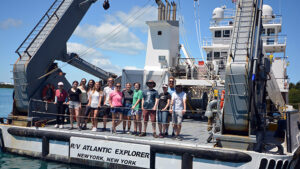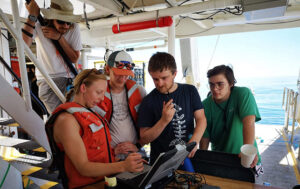How Do We Understand the Ocean?

The Modern Observational Oceanography course, which was offered this summer at BIOS, gives students the unique opportunity to gain practical experience in the field of observational oceanography. The 3-week course includes a day-long research cruise on the R/V Atlantic Explorer, allowing students to see first-hand the variety of technologies and methods used to understand the ocean.
This summer marks the third year that BIOS has offered its Modern Observational Oceanography (MOO) course to undergraduate and postgraduate students enrolled in oceanography programs. The course aims to provide students with a broad introduction to, and practical experience in, the field of observational oceanography—a rapidly developing area of study that focuses on using a variety of technologies and methods to further our understanding of how the physical state of the ocean is changing.
Over a three-week period, eleven students—who this year hailed from Canada, Germany, New Zealand, the United Kingdom, and the United States—participated in a variety of lectures, laboratory training, and fieldwork designed to introduce them to current oceanographic research questions and the methods being used to investigate them. The course was co-taught by a team of instructors, including Professor Nicholas Bates, a chemical oceanographer who investigates marine carbon and nutrient cycling; Rod Johnson, a physical oceanographer with a background in deep-sea oceanography and time-series; Ruth Curry, manager of the Mid-Atlantic Glider Initiative and Collaboration (MAGIC) lab at BIOS; and Sam Stevens, a former BIOS research technician and current doctoral student at the University of British Columbia in Canada.
For most participants, the highlight of the course was a day-long research cruise on the R/V Atlantic Explorer out to Hydrostration ‘S,’ a deep-water research mooring off Bermuda. Established in 1954, Hydrostation ‘S’ is the longest-running time-series of its kind in the world, acquiring measurements of the ocean’s physical properties every two weeks. During the cruise, students used the onboard CTD (conductivity, temperature, and depth) instrument to conduct an ocean profile down to 11,500 feet (3,500 meters). They also deployed a glider and made measurements of the upper ocean (down to 1,600 feet, or 500 meters) to help characterize circular, relatively short-lived currents called “mesoscale eddies” that play a role in heat transfer in certain parts of the ocean.

During the research cruise, students observed the deployment of an autonomous underwater vehicle, called a glider. These torpedo-shaped vehicles are equipped with sensors that collect data on a variety of oceanographic variables, such as dissolved oxygen, temperature, ocean currents, and conductivity (used to calculate salinity). Cordielyn Goodrich, a research technician for the glider lab at BIOS, showed a group of students how researchers use freewave radio to communicate with a recently-launched glider prior to deploying it on a mission. [From left to right: Adam Fagan, Cordielyn Goodrich, Jonathan Chapman, Anthony Lindley, and Trevor McMullen]
Trevor McMullen, 21, an undergraduate student in marine biology at the University of West Florida in the United States was sent the course application by his department head, as he had yet to take an oceanography course in his degree program. “My favorite part of the course was watching the CTD sensors show changes in the water as they went to depth,” McMullen said. “It reflected everything we learned in the lectures and helped me put together a more comprehensive understanding of the ocean.”
For more information on the Modern Observational Oceanography course, please visit the Summer Courses page on the BIOS website.
